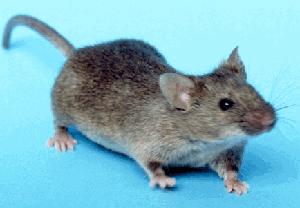Bug of the Month for December: Mouse
Mice aren’t bugs, obviously. But hey! Neither are spiders, so, just roll with it. Mice can still be a very pesky pest to deal with. It’s hard to believe not even a mouse would be stirring on the night before Christmas because mice are always on the go, and they are nocturnal. Plus, they’d probably love to get their hands on some of those cookies you left out for Santa.
Here are a few things you need to know about the house mouse and how to deal with those little guys:
What do house mice look like?

Image courtesy of Wikipedia
Mice are tiny grey or brown rodents that can be 2-4 inches in length and have a long, scaly tail. They have pointed snouts and ears and four legs.
How do mice behave?
Mice are very sneaky creatures that are able to squeeze through small spaces to find warmth and food. They tend to eat insects and seeds, but have known to eat almost anything that is left around the house.
The house mouse tends to stay indoors, although they can survive outside as well. They are very adaptable to their surroundings. Mice can also jump really high: almost ten times their height! This allows them to be able to reach even more places.
The female mouse can produce 30 offspring or more, so if you see any mice around your house, there are probably several more.
Where do mice live?
Mice live on every continent and almost every country in the world. They are highly adaptable and can survive in almost any climate. They are the most common rodent pest in the world.
Mice make their home indoors for the most part and can make nests out of almost any material such as fabrics, packing supplies, and insulation. They also tend to prefer dark areas as they are nocturnal, but it is not uncommon to see them during the day.
Do mice pose any health threats?
Rodent feces can spread bacteria through touch and food contamination. This can cause severe diseases such as salmonella poisoning, Rat Bite Fever, and even Bubonic Plague! Not only is coming in contact with rodent feces dangerous, so is even breathing it in!
Most of these diseases are very dangerous, even deadly, but also very uncommon. The most common of these diseases is salmonella poisoning, which is a type of food poisoning. Symptoms include nausea, diarrhea, and fever.
How can I prevent a mouse infestation?
As is common with most pests, the best way to keep mice away is to make sure all doors and windows in your house are sealed and protected.
It is best to store things off of the floor and make sure the right rain gutters are installed so that rainwater will properly be diverted away from the house. It is also very important to keep your house clean and not leave any food lying around.
Signs of a mouse infestation include small droppings, torn fabrics and other materials, and damaged food packaging.
If you see any of these signs, don’t hesitate to call Absolute Pest Control at (615)220-1933 or click here to set up an appointment today.
Sources:
http://www.pestworld.org/pest-guide/rodents/house-mice/
